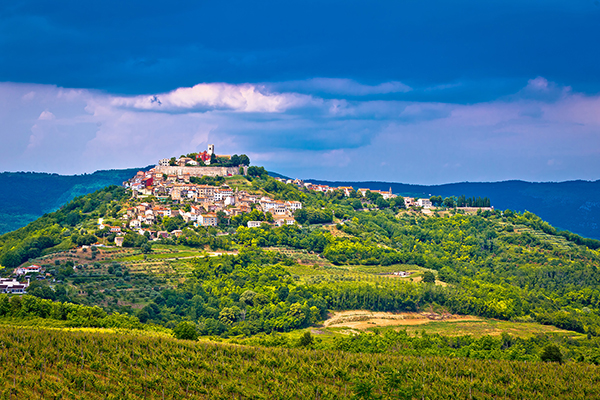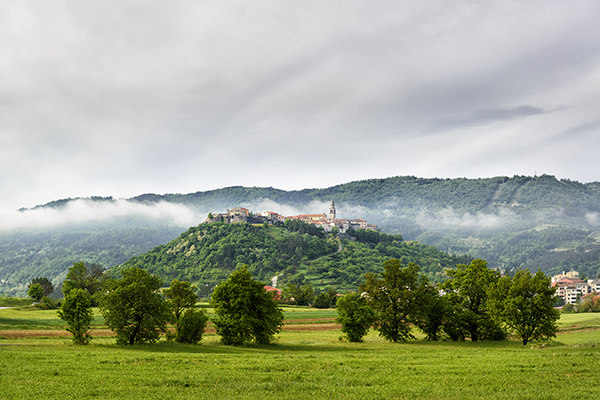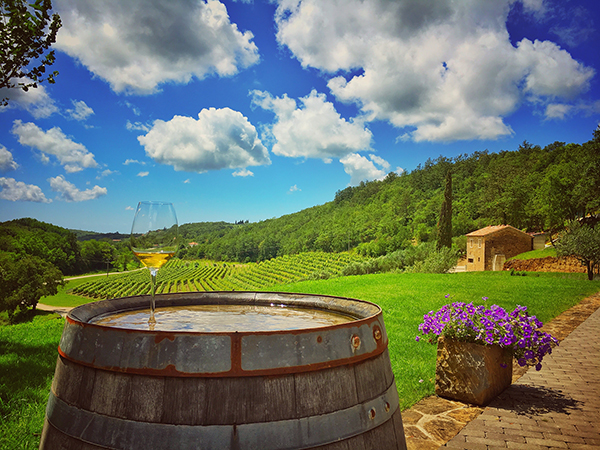5 hilltop towns you need to visit on Croatia's Istrian Peninsula

Get high on the Istrian Peninsula: these pretty hilltop towns are well worth a visit.
Istria, the strawberry-shaped peninsula in the northwest of Croatia, can be divided into two parts. The ‘blue’ part – the coastal towns and villages – and the ‘green’ part, which is essentially everything inland.
The blue part gets the lion’s share of the attention and tourists. It’s understandable: the coastline is punctuated by some of Croatia’s most attractive towns (Rovinj, Poreč, Pula) and some of its key historical sites (a Roman amphitheatre and Euphrasian Basilica).
But the ‘green’ part – the under-developed interior with its medieval hilltop towns, perched villages, truffle-rich woods, fertile valleys, olive groves and vineyards – is considered by many to be the real Istria. Here are six of the best places to visit in ‘green’ Istria…
1. For art and music: Grožnjan
Many tourists’ favourite, Grožnjan has everything you want from an Istrian hilltop town. Everything except a hotel. When you step through the main gate on the eastern side of the walled town, you really do feel like you are stepping back into medieval times.
The honey-brown stone houses are tightly packed, the car-free streets are cobbled, the alleyways are narrow and crooked, there’s a stray cat at every turn, and the main square abuts the Baroque church.
The three main attractions are the artists’ studios, various summer music festivals and the views across the olive groves and vineyards to the Mirna Valley, the sea 10 miles away and Istria’s only mountain, Učka.
After World War II, the town was all but deserted, so in 1965 the Yugoslav government encouraged artists and musicians to set up studios there. More than 20 galleries now display creations from painters, potters and sculptors. Grožnjan is also home to the International Cultural Centre of Young Musicians, and many of the students take part in outdoor concerts in the summer. The musical highlight is the Jazz Is Back festival in July.
Where to eat and sleep: Accommodation in the town is either in private apartments or holiday homes, but five miles away is one of Istria’s top boutique hotels, the San Rocco in Brtonigla. Eat at Kaya Energy Bar, a café with great views.
 Jurij108/Shutterstock
Jurij108/Shutterstock
2. For films buffs: Motovun
With its narrow streets, art studios and craft shops, Motovun feels similar to Grožnjan, but it’s bigger, higher, busier, and has a brilliant rampart walk.
The historic town centre – with its 13th-century bell tower and Municipal Palace, and a 17th-century church – is particularly well preserved.
At the end of July, the main square becomes one of the venues for Motovun’s five-day film festival (motovunfilmfestival.com). The annual event tries to showcase as many independent films “from as many countries as possible, in order to show that the world of film is much wider and more colourful than it often seems”.
Where to eat and sleep: Konoba Mondo, just outside the town gates, has a relaxed vibe and serves dishes made with local ingredients. Stay at Hotel Kaštel, a 3-star hotel in a refurbished 16th-century palace, or Villa Borgo, a small B&B with a great outdoor terrace.
 xbrchx/Shutterstock
xbrchx/Shutterstock
3. For truffles: Livade
Many of the hilltop towns have truffle shops, but the top place for all things truffle is the tiny village of Livade, just north of Motovun. Within its luscious countryside, Livade has spring and summertime black truffles as well as rarer autumn-time white truffles. The latter are the most expensive fungi in the world, so you’ll probably have to make do with just a few shavings on your pasta at one of the many truffle restaurants along the main street.
The king of this fungi is Giancarlo Zigante, who owns one of the best truffle restaurants in town, as well as a truffle emporium. He has spent his life hunting and preparing truffles, and is in the Guinness Book of Records with the world’s largest white truffle (all 1.31kg of it).
Where to eat and sleep: The excellent Zigante restaurant has bedrooms too, so you won’t have to stumble too far after all those truffles.
4. For a secret wine bunker & a massive omelette: Buzet
First impressions of Buzet, the second-largest town in Istria’s interior, are not exactly inspiring. A nondescript new town has grown around the foot of the hill, but east of the town there’s little underground surprise.
Behind large wooden door in the hillside lies a bunker where the Italian occupation stored 80,000 litres of water during the 1930s. In the 1950s it was turned into an atomic bomb shelter for locals and in 20 years later the Yugoslav government knocked the four cement tanks into a winery.
It’s now in the hands of talented young winemaker Dimitri Brečević, who is producing traditional, old-style wine from the main local grape varieties, the white Malvazija Istriana and the red Teran under the name Piquentum.
Atop the hill and through a gate that dates back to 1547, the pleasant medieval old town has tightly-packed houses, an old church, a deep well, cobbled streets and historic walls.
 Jhee/Shutterstock
Jhee/Shutterstock
The top festival here, the Buzetska Subotina, marks the start of the white truffle-hunting season, so it’s usually held in the second weekend of September. People dress up in historic costumes and eat a huge white-truffle omelette cooked in the main square while local bands rock on.
Where to eat and sleep: Hotel Vela Vrata, which has a tiny swimming pool and a good restaurant.
5. For serious wine tasting: Momjan
The best view of the impressive medieval castle of Momjan is from the terrace of the Kozlović winery, with a glass in hand, of course. The family-run winery is a stunning modern edifice where fresh, clean, fruity wines are produced.
Another family winery near Momjan that welcomes tourists is the Tuscan-like stone farmhouse of Kabola, a certified organic producer. Winemaking started here in 1891, but it is only since 2005 that Marino Markežić has switched from producing wine for his restaurant to making wine for the international market.
Here, you can taste Malvazijas in a variety of guises – including a typical fresh and fruity version, a barrel-aged riserva, a sparkling wine and the Kabola Malvazija Amfora, which is aged in large clay pots (amphorae) buried in the garden.
Where to eat and sleep: Stay at Casa Romantica La Parenzana in Volpija, a 10-minute drive away and eat at one of the region’s finest restaurants, Stari Podrum, near the Kozlović winery.
 Phant/Shutterstock
Phant/Shutterstock
Getting around
Istria is best explored with your own vehicle, though many of the key towns and villages – including Grožnjan, Livade, Motovun – are linked by the Parenzana. This former narrow-gauge railway line connected the Italian port of Trieste and Istrian seaside resort of Poreč and us now a hiking and cycling trail.
Comments
Be the first to comment
Do you want to comment on this article? You need to be signed in for this feature